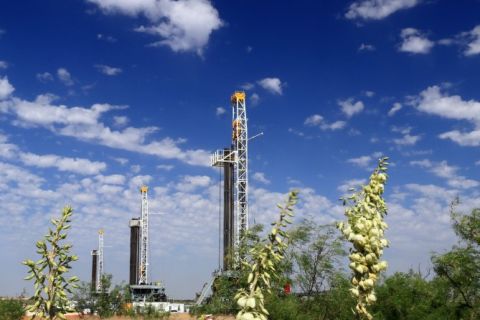White G. Jee, INEOS Olefins & Polymers USA, Houston, Texas;
and Steve D. Sandstrum, ISCO Industries LLC, Louisville, Kentucky
Over the last five years, North American gas utilities have become informed on the differences between the ISO and ASTM systems in stress rating thermoplastic piping materials and the various material and pipe requirements of gas pipe standards ISO 4437 and ASTM D2513.
Polyethylene (PE) gas pipe produced from resins meeting the criteria for the PE 100 designation were first introduced on an international scale in the late 1980s. These piping products have grown to become recognized as the international standard for long-term performance in the use of polyethylene gas pipe.
The success that these higher performance piping products have realized has been based on three specific performance properties: long-term hydrostatic strength, exceptional resistance to slow crack growth, and resistance to failure by rapid crack propagation (RCP).
The goal here is to examine the consensus standards development of the PE 4710 thermoplastic material designation code, so as to recognize these three properties in relationship to the testing and performance criteria of the North American ASTM-based standards system. In this process, it also desirable to include a brief analysis on the significance of the PE 4710 designation code within the North American standards system, and the potential impact that the use of these products will have in the future.
Background
The use of polyethylene pipe has grown considerably over the past forty-plus years. Factors driving this growth have included polyethylene pipe’s versatility, material improvements, standards development, expansion of innovative construction techniques and growing concerns over the integrity of an aging infrastructure. Since the first use of high-density polyethylene (HDPE) pipe in the 1960s, the natural gas industry has become educated on the numerous advantages of HDPE pipe over other types of piping materials. The fact that HDPE piping systems are safe, leak-free and durable is of paramount importance to this industry. In fact, studies have indicated that in excess of 90% of all new gas services and small diameter mains installed today are HDPE pipe.
Polyethylene is a polymer prepared by polymerization of ethylene as the sole monomer. In common usage, this essentially means no less than 85% ethylene and no less than 95% total olefins. Its thermoplastic characteristics allow it to be processed by a variety of means (blowmolding, injection molding, and extrusion) and used in a wide variety of applications. One of these applications (the focus here) is HDPE pipe and fittings.
Material designation code
The thermoplastic pipe material designation code is a set of ciphers and letters for the designation of stress-rated thermoplastic compounds. The code consists of two or three letters to indicate the abbreviation as listed in Terminology ASTM D 1600, for the type of thermoplastic resin – followed by four Arabic numerals – two to describe the short-term properties, in accordance with the ASTM standard being referenced, and two to designate the hydrostatic design stress when tested in water at 73°F (23°C) in units of 100 psi, with any decimal figures dropped.
For polyethylene, the thermoplastic material designation codes PE 2406 and PE 3408 are most commonly used today. Earlier generations of PE piping materials used codes referred to as PE 2304, PE 2306, PE 3306, and PE 3406 before being replaced with the current generation of PE 2406 and PE 3408 materials. The first numerical digit refers to the density cell classification as defined in ASTM D 3350. The second numerical digit refers to the slow crack growth resistance cell classification also defined in ASTM D 3350.
Higher performance piping materials
As indicative of any progressive industry, continuous improvement is needed to expand the opportunities for increased applications of polyethylene pipe. In the mid-1980s, extensive research was undertaken on an international scale to further improve on the recognized performance capabilities of the then-current polyethylene piping systems. The result of this research was the introduction of a new level of performance in polyethylene pipe which was designated as PE 100 in accordance with the ISO standards systems prevalent throughout the world outside of North America.
As these higher-performance piping materials became more accessible in North America, the need to compare the similarities and differences between the ASTM and ISO standards began. The initial education began with comparing the difference in methodology for pressure design of polyethylene piping materials. Subsequently, a series of technical papers addressing the differences between PE 3408 and PE 100 materials and performance properties were developed and presented to the American Gas Association community, and a series of technical notes and literature were developed by the Plastics Pipe Institute (PPI) for education of ASTM and ISO standard comparisons.
As the North American polyethylene piping industry and its end-users became more familiar with both ASTM and ISO standards and test methods, it became evident that a pipe paradox exists, and a consensus means was needed to harmonize or utilize the higher-performance properties of these materials across the two widely recognized standards systems.
The pipe paradox and consensus agreement
The success and growth of HDPE in pipe applications has led to continued research in improvements in the technical performance of the polymers, pipe manufacturing refinements, and standards evolution for materials, pipe product and end-use. Continued improvements in these three key areas have led to further growth and acceptance of HDPE piping. This led to further research, and gave rise to an “evolutionary cycle” on a global level.
The global evolution of HDPE pipe has not been without challenge, especially as it pertains to the standards arena. ISO standards and designation codes are recognized worldwide, and ASTM standards and designation codes are recognized predominantly in North America.
The evolution of HDPE pipe use has occurred in the context of two separate and equally valid standards systems, ISO and ASTM. This has resulted in a unique paradox: the same HDPE piping material evaluated and used under two equally recognized standards systems (ISO and/or ASTM) resulting in substantially different pressure ratings with the same end-uses (Table 1). Both systems and protocol are equally valid, and both systems are extensively utilized on a worldwide basis.
Within the ISO system, the PE material designation (PE 63, PE 80, and PE 100) refers to a categorization of long-term hydrostatic strength based upon ISO 9080 and ISO 12162. Within the ASTM system, the thermoplastic material designation code is used as explained above.
In order to resolve this paradox, the PE piping industry reached a consensus to build a means of differentiation within the ASTM standards system. The consensus was achieved through discussions in various industry association task groups, such as the PPI, Hydrostatic Stress Board (HSB), and American Gas Association Plastics Materials (AGA-PMC) Committee. Differentiation is based on the following three key findings related to differences that exist between PE 100 and PE 3408 grades:
- A notably higher HDPE base resin density for the PE 100 resin under the ISO system.
- A significantly higher level of resistance to slow crack growth (SCG) as determined by PENT or notched pipe test.
- A greater degree of confidence in the linearity of the 50-year extrapolation of the stress-rupture curve generated for these materials when evaluated under the ASTM D2837 protocol.
These three properties (density, SCG, and long-term hydrostatic strength [LTHS] treatment within ASTM/PPI methodology), which form the basis for differentiation within the ASTM pipe rating protocol, are the same properties that form the basis for the thermoplastic piping material designation code established in ASTM F412, the source for the familiar PE 2406 and PE 3408 designation. Therefore, revisions to ASTM standards and ASTM/PPI protocol have been undertaken to provide the basis for differentiation of the higher performance grades within North American market while preserving the familiarity of the PE XXXX thermoplastic materials code designation.
Revision of density cell classification
The initial action taken to build a means of differentiation within the ASTM standards system was to create a density cell classification in ASTM D 3350 that would segregate the density cell class of PE 3408 materials from PE 100 materials (referred to hereafter as high-performance PE materials). This was done to eliminate the cross-referencing of ISO nomenclature with ASTM material codes, since actions are strictly in the ASTM standards domain.
In late 2003, an ASTM Committee D20 project on revision of ASTM D 3350 was initiated to create a density cell classification as an initial means of developing a new material designation code for higher performance polyethylene piping materials. The proposed revision was to transfer the previous cell class 4 (>0.955 g/cc) to cell class 5; and to divide the previous cell class 3 (>0.940 – 0.955 g/cc) to a range of >0.940 to 0.947 g/cc as cell class 3, with a range of >0.947 to 0.955 g/cc as cell class 4.
The proposed splitting of the density cell class will require no categorization change to the current materials designated as PE 2406 and PE 3408, but will provide an avenue to differentiate the higher performance PE materials which typically will now fall into cell class 4. In late 2004, the project was completed and the standard revision was published in ASTM D 3350-04 (Table 2).
Slow crack growth resistance
Upon completion of the above project in 2004, an ASTM D20 project on revision of ASTM D 3350 was initiated to address the significantly higher level of resistance to slow crack growth (SCG) that high-performance PE materials have over traditional PE 3408 materials. The industry consensus was to establish a 500-hour minimum PENT requirement for high-performance PE materials. Since the piping industry did not utilize the PENT of 0.1, 1 and 3 hours as noted in cell classes 1, 2 and 3, respectively, the values were deleted from the PENT cell classes.
In order to create a cell class for a PENT value of 500 hours, the cell class 7 was designated as 500 hours and cell class 8 was created as “specify value.” Additionally, and very significantly, the sentence in section 4.3 of D3350 “When the Property 5 (slow crack growth resistance) value is 4 or 6, a 4 shall be used in the grade designation” was removed. This sentence was originally put into D 3350 in order to keep the familiar “PE 2406 and PE 3408” designation, even though the materials had much higher slow crack growth resistance. In late 2005, the project was completed, and the standard revision was published in ASTM D 3350-05 (Table 3).
Increased design factor
The higher-performance PE materials exhibit much greater resistance to slow crack growth and a greater degree of confidence in the linearity of the 50-year extrapolation of the stress-rupture curve when evaluated under the ASTM D2837 protocol. For these reasons, the HSB-PPI addressed the technical justification and means to utilize an increased design factor for high performance PE materials. After studying the issue for more than two years, the HSB agreed that a minimum design factor of 0.63 for water can be applied to high performance PE materials and piping systems, provided the following criteria are met:
- Exceed the 500-hour resistance to slow crack growth when tested in accordance to ASTM F 1473 (PENT).
- Attain the 50-year extrapolation requirements that substantiate the stress-rupture data at room temperature according to ASTM D 2837.
- Provide a lower confidence limit (LCL)/LTHS ratio of 90% or higher when tested in accordance with the requirements of ASTM D 2837.
The improved technical performance of the PE 4710 materials and the higher design factor for water has created interest in analyzing the design factor used in gas distribution within the United States. To that end, a task group sponsored and funded by the AGA-PMC, PPI, ODT, GRI, and GPTC has been formed to investigate the possibility of using a higher design factor for gas distribution with these higher-performance materials. The information generated in this project is expected to provide a technical justification for raising the design factor in natural gas distribution in the United States from the current 0.32 to 0.40 similar to that in use in Canada at this time. This information will be used to support a petition to the DOT/PHMSA for the increased design factor of natural gas distribution. The target for completion of this initiative is 2007.
Additional standards development
Based upon the completed actions in the revisions of ASTM D 3350 and the technical justification for an increased design factor of 0.63, the traditional PE 2406 and PE 3408 material code designations can be modified to utilize the actual SCG cell class of the designation.
More importantly, a new thermoplastic material designation code (PE 4710), consistent with the definitions as per ASTM F412, can be utilized for the higher performance PE materials similar to those designated as PE 100 within the ISO system. Appropriate pipe application standards under the jurisdiction of ASTM F17 Committee on Plastics Piping Systems are being revised to incorporate the new thermoplastic material designation code for high-performance PE materials (PE 4710) and the modified versions (PE 2708, PE 3608, PE 3708, PE 3710, and PE 4708) previously designated as PE 2406 or PE 3408. At this time, the various ASTM F17 projects are in-progress, in either task group or subcommittee balloting level.
Additionally, an ASTM Committee F17 project that addresses the RCP properties is in-progress at the subcommittee level. This project will ultimately incorporate RCP requirements in the Annex of ASTM D 2513.
Benefits of PE 4710
High-performance PE 4710 materials offer an improvement in long-term strength, resistance to slow crack growth, and resistance to rapid crack propagation. These improved performance properties provide the technical basis for the higher design factor of 0.63 for water service and potentially a design factor of 0.40 for natural gas distribution.
Ultimately, this allows the design engineer and owner/end-user the capability to take advantage of the improved properties and utilize these materials at a higher pressure than current PE 3408 piping systems within the constraints of the applications or regulations. Alternatively, the design engineer and owner/end-user can potentially operate at the same working pressures but with a slightly lighter wall pipe using high performance PE 4710 materials.
As the availability of high performance PE 4710 materials become more prevalent in North America, the design engineer and owner/end-user will have the option to utilize the distinct advantages of polyethylene piping systems as the material of choice in new and existing applications.
Acknowledgments
The authors wish to thank Stephen Boros, Technical Director of the Plastics Pipe Institute, for his contribution and review of this article. Based on a paper presented at the American Gas Association Operations Conference, May 2-4, 2006, Boston, Massachusetts.
Recommended Reading
Permian Activity in ‘Low-to-no-growth’ Mode for First Half
2024-02-22 - After multiple M&A moves in 2023 and continued E&P adherence to capital discipline, Permian Basin service company ProPetro sees the play holding steady.
Analysts, SLB Execs See Stability in $7.7B ChampionX Deal
2024-04-04 - The acquisition of ChampionX vaults SLB’s chemical production business to No. 1 globally and orients SLB's business toward resource recovery that is less tied to price volatility.
Vital Energy's ‘Wildly Successful’ 2023 ‘Small Ball’ M&A Now in ‘Moneyball’ Mode
2024-02-23 - The operator added big runs in $1.6 billion of 2023 deals. Now Vital is looking to make more out of its hits via geology and geophysics, including steals “for free.” Still, it might pick up big consolidators’ cast-offs.
E&P Highlights: Feb. 12, 2024
2024-02-12 - Here’s a roundup of the latest E&P headlines, including more hydrocarbons found offshore Namibia near the Venus discovery and a host of new contract awards.
Sold in 66 Days: Inside the Diamondback-Endeavor Deal
2024-03-26 - Diamondback Chairman and CEO Travis Stice first offered “at least $25 billion” for Endeavor Energy Resources on Dec. 8. The deal closed just weeks later for $26 billion.





